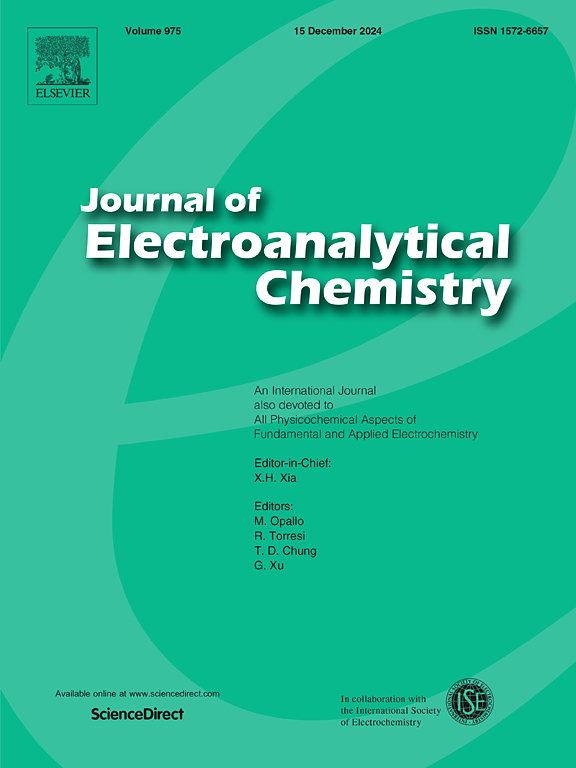The regulation of low-valence cobalt by pH: Efficient catalytic electrooxidation of sodium borohydride
IF 4.1
3区 化学
Q1 CHEMISTRY, ANALYTICAL
引用次数: 0
Abstract
Transition metal cobalt-based materials show good catalytic activity for borohydride oxidation reaction, and the valence state of cobalt is an important factor affecting the catalytic activity. By changing pH with (NH4)2SO4 to adjust the valence state of Co, cobalt-based catalysts (CoP-x/Ni@CP) that contain various amount of low-valence cobalt (Coδ+, 0 < δ ≤ 1) are successfully constructed. The addition of (NH4)2SO4 reduces the pH of the solution (from 6.86 to 5.64), which result in an increase of Coδ+ (from 1 % to 24.8 %). Coδ+ can effectively break the B![]() H bond, so efficient catalysis of borohydride oxidation is realized. However, with more B
H bond, so efficient catalysis of borohydride oxidation is realized. However, with more B![]() H bonds are broken, intensification of side reactions and change of electrode macrostructure may lead to a decrease of performance. Therefore, it is important to regulate the content of Coδ+ to optimize catalysis performance. In 1 M NaOH+0.1 M NaBH4, the current density of CoP/Ni@CP (Coδ+ content: 17.3 %) prepared by 1 M (NH4)2SO4 is as high as 548 mA cm−2 (0 V). The assembled direct sodium borohydride fuel cell (DBFC) can reach a maximum power density of 112 mW cm−2. This study provides a new idea for controlling valence state of elements to achieve improvement of properties and promoting practical application of DBFC.
H bonds are broken, intensification of side reactions and change of electrode macrostructure may lead to a decrease of performance. Therefore, it is important to regulate the content of Coδ+ to optimize catalysis performance. In 1 M NaOH+0.1 M NaBH4, the current density of CoP/Ni@CP (Coδ+ content: 17.3 %) prepared by 1 M (NH4)2SO4 is as high as 548 mA cm−2 (0 V). The assembled direct sodium borohydride fuel cell (DBFC) can reach a maximum power density of 112 mW cm−2. This study provides a new idea for controlling valence state of elements to achieve improvement of properties and promoting practical application of DBFC.

pH对低价钴的调控:硼氢化钠的高效催化电氧化
过渡金属钴基材料对硼氢化物氧化反应表现出良好的催化活性,而钴的价态是影响催化活性的重要因素。用(NH4)2SO4改变pH值来调节Co的价态,从而制备出含有不同数量的低价钴(Coδ+, 0 <;δ≤1),构造成功。(NH4)2SO4的加入降低了溶液的pH(从6.86降低到5.64),导致Coδ+的增加(从1%增加到24.8%)。Coδ+能有效地破坏BH键,实现了硼氢化物氧化的高效催化。然而,随着氢键断裂的增加,副反应的加剧和电极宏观结构的改变可能导致性能的下降。因此,调节Coδ+的含量对优化催化性能具有重要意义。在1 M NaOH+0.1 M NaBH4条件下,1 M (NH4)2SO4制得的CoP/Ni@CP (Coδ+含量:17.3%)电流密度高达548 mA cm−2 (0 V)。所制备的直接硼氢化钠燃料电池(DBFC)最大功率密度可达112 mW cm−2。本研究为控制元素的价态以达到改善DBFC性能和促进其实际应用提供了新的思路。
本文章由计算机程序翻译,如有差异,请以英文原文为准。
求助全文
约1分钟内获得全文
求助全文
来源期刊
CiteScore
7.80
自引率
6.70%
发文量
912
审稿时长
2.4 months
期刊介绍:
The Journal of Electroanalytical Chemistry is the foremost international journal devoted to the interdisciplinary subject of electrochemistry in all its aspects, theoretical as well as applied.
Electrochemistry is a wide ranging area that is in a state of continuous evolution. Rather than compiling a long list of topics covered by the Journal, the editors would like to draw particular attention to the key issues of novelty, topicality and quality. Papers should present new and interesting electrochemical science in a way that is accessible to the reader. The presentation and discussion should be at a level that is consistent with the international status of the Journal. Reports describing the application of well-established techniques to problems that are essentially technical will not be accepted. Similarly, papers that report observations but fail to provide adequate interpretation will be rejected by the Editors. Papers dealing with technical electrochemistry should be submitted to other specialist journals unless the authors can show that their work provides substantially new insights into electrochemical processes.

 求助内容:
求助内容: 应助结果提醒方式:
应助结果提醒方式:


